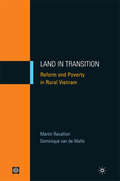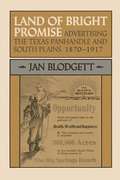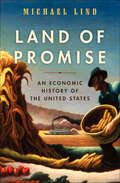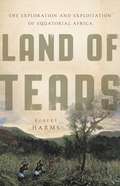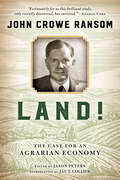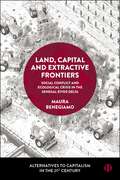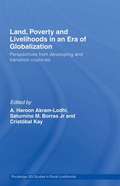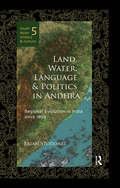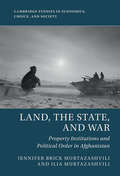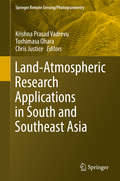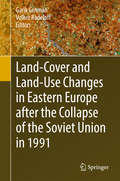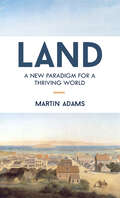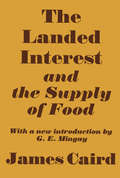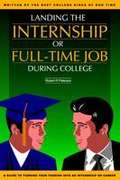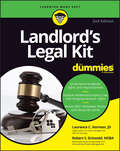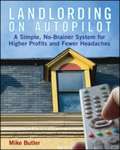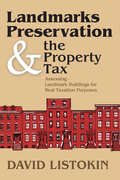- Table View
- List View
Land in Transition
by Dominique van de Walle Martin RavallionThis book is a case study of Vietnam's efforts to fight poverty using market-oriented land reforms. In the 1980s and 1990s, the country undertook major institutional reforms, and an impressive reduction in poverty followed. But what role did the reforms play? Did the efficiency gains from reform come at a cost to equity? Were there both winners and losers? Was rising rural landlessness in the wake of reforms a sign of success or failure? 'Land in Transition' investigates the impacts on living standards of the two stages of land law reform: in 1988, when land was allocated to households administratively and output markets were liberalized; and in 1993, when official land titles were introduced and land transactions were permitted for the first time since communist rule began. To fully assess the poverty impacts of these changes, the authors' analysis of household surveys is guided by both economic theory and knowledge of the historical and social contexts. The book delineates lessons from Vietnam's experience and their implications for current policy debates in China and elsewhere.
Land of Bright Promise: Advertising the Texas Panhandle and South Plains, 1870-1917
by Jan Blodgett"It shall be the chosen land, perpetual sunshine shall kiss its trees and vines, and, being storied in luscious fruits and compressed into ruddy wine, will be sent to the four points of the compass to gladden the hearts of all mankind . . . They will breathe the pure and bracing air, bask in the healing sunshine, drink the invigorating wine, and eat the lifeprolonging fruit. "-from a brochure advertising the Staked Plains fromthe Missouri Pacific Railway Company, 1889Land of Bright Promise is a fascinating exploration of the multitude of land promotions and types of advertising that attracted more than 175,000 settlers to the Panhandle-South Plains area of Texas from the late years of the nineteenth century to the early years of the twentieth. Shunned by settlers for decades because of its popular but forbidding image as a desert filled with desperados, savage Indians, and solitary ranchers, the region was seen as an agricultural and cultural wasteland. The territ0ry, consequently, was among the last to be settled in the United States. But from 1890 to 1917, land companies and agents competed to attract new settlers to the plains. To this end, the combined efforts of local residents, ranchers and landowners, railroads, and professional real estate agents were utilized. Through brochures, lectures, articles, letters, fairs, and excursion trips, midwestern farmers were encouraged to find new homes on what was once feared as the "Great American Desert. " And successful indeed were these efforts: from 13,787 in 1890, the population grew to 193,371 in 1920, with a corresponding increase in the amount of farms and farm acreage. The book looks at the imagination, enthusiasm, and determination of land promoters as they approached their task, including their special advertisements and displays to show the potential of the area. Treating the important roles of the cattlemen, the railroads, the professional land companies, and local boosters, Land of Bright Promise also focuses on the intentions and expectations of the settlers themselves. Of special interest are the fifteen historical photographs and reproductions of promotional pieces from the era used to spur the land boom. What emerges is an engaging look at a critical period in the development of the Texas Panhandle and an overview of the shift from cattle to agriculture as the primary industry in the area.
Land of Promise: An Economic History of the United States
by Michael LindMichael Lind’s Land of Promise is "[an] ambitious economic history of the United States . . . rich with details" (New York Times Book Review).How did a weak collection of former British colonies become an industrial, financial, and military colossus? From the eighteenth to the twenty-first centuries, the American economy has been transformed by wave after wave of emerging technology: the steam engine, electricity, the internal combustion engine, computer technology. Yet technology-driven change leads to growing misalignment between an innovative economy and anachronistic legal and political structures until the gap is closed by the modernization of America's institutions—often amid upheavals such as the Civil War and Reconstruction and the Great Depression and World War II.When the U.S. economy has flourished, government and business, labor and universities, have worked together in a never-ending project of economic nation building. As the United States struggles to emerge from the Great Recession, Michael Lind clearly demonstrates that Americans, since the earliest days of the republic, have reinvented the American economy—and have the power to do so again.
Land of Tears: The Exploration and Exploitation of Equatorial Africa
by Robert HarmsA prizewinning historian's epic account of the scramble to control equatorial Africa In just three decades at the end of the nineteenth century, the heart of Africa was utterly transformed. Virtually closed to outsiders for centuries, by the early 1900s the rainforest of the Congo River basin was one of the most brutally exploited places on earth. In Land of Tears, historian Robert Harms reconstructs the chaotic process by which this happened. Beginning in the 1870s, traders, explorers, and empire builders from Arabia, Europe, and America moved rapidly into the region, where they pioneered a deadly trade in ivory and rubber for Western markets and in enslaved labor for the Indian Ocean rim. Imperial conquest followed close behind. Ranging from remote African villages to European diplomatic meetings to Connecticut piano-key factories, Land of Tears reveals how equatorial Africa became fully, fatefully, and tragically enmeshed within our global world.
Land or Death: The Peasant Struggle in Peru
by Hugo Blanco"LAND OR DEATH," says Peter Camejo in his introduction, "constitutes one of the most significant contributions to the theory and practice of Latin American revolution since the Cuban Revolution." It not only describes the conditions of peasant life, but tells the fascinating story of thousands of Quechua Indians who began to take back the lands stolen from them. Drawing on his experience as a leading figure in this mass peasant movement, Blanco takes issue with those who believe the revolution in Latin America can come through either elections or small groups of dedicated, but isolated, guerrillas. Hugo Blanco, a principal organizer of the peasant movement in Peru, was sentenced to a twenty-five year prison term for his activities. Written from inside the famous El Fronton Island prison, Land or Death illustrates Blanco's refusal to be silenced by the government. Blanco was freed in 1970 under the pressure of an international campaign.
Land!: The Case for an Agrarian Economy
by John Crowe RansomFrom a National Book Award winner, &“an indictment of a system that values accumulation, shareholder profit . . . over . . . self-sufficiency, and solidarity.&” (Robert Neuwirth, author of Stealth of Nations: The Global Rise of the Informal Economy) John Crowe Ransom's Land! is a previously unpublished work that unites the accomplished literary scholar&’s poetic sensibilities with an examination of economics at the height of the Great Depression. Politically charged with Ransom's aesthetic beliefs about literature and his agrarian interpretation of economics, Land! was long thought to have been burned by its author after he failed to find a publisher. Thankfully, the manuscript was discovered, and we are now able to read this unique and interesting contribution to the Southern Agrarian revival. After the publication of the Agrarian movement manifesto I&’ll Take My Stand in 1930, Ransom, a contributor, became convinced that the book had not adequately proposed an economic alternative to Northern industrialism, which had fairly obliterated the Southern way of life. Land! was Ransom's attempt to fill this gap. In it he presents the weaknesses inherent in capitalism and proposes instead that agrarianism, which could flourish alongside capitalism, would relieve the problems of unemployment. America, Ransom claims, is unique in offering this opportunity because, unlike in European countries, land is plentiful. &“Ransom joins Lauck in championing the values fostered by rural and small-town America. Is this just wishful thinking? Perhaps, and yet don&’t we sometimes need to step back before we can leap forward?&” —The Washington Post &“Ransom&’s affection for traditional rural culture provides an enjoyable warm streak in the book.&” —Choice &“Mr. Ransom&’s highly original argument unfolds in beautifully written prose. . . . engaging and thought-provoking.&” —George Core, retired editor of The Sewanee Review
Land, Capital and Extractive Frontiers: Social Conflict and Ecological Crisis in the Senegal River Delta (Alternatives to Capitalism in the 21st Century)
by Maura BenegiamoThis book examines ‘land-grabbing’ - its colonial roots and the fraught relationship between capital and nature amidst the current global socio-ecological crisis. Through ethnographic and archival research, Maura Benegiamo investigates an Italian company’s acquisition of 20,000 hectares in Senegal’s River Delta for agrofuel production and delves into the struggles of pastoral communities affected by the project. Through this landmark case, the book shows how European energy and global food security policies are reshaping rural spaces, expanding agrarian extractivism in sub-Saharan Africa. By shedding light on how contemporary capital–nature relationships perpetuate socio-ecological crises and colonial models, the book highlights the enduring forms of opposition to these processes. At the heart of these struggles lies a crucial question: how can we understand today’s crises while reclaiming alternative ways of living, producing and inhabiting the land?
Land, People and Economy of Pakistan: A Geographic Perspective
by K. R. Dikshit Jutta K. DikshitThe book unravels the complexity of Pakistan’s physical terrain, from the Arabian Sea coast to the Himalayan heights, focusing on its bio-climatic environment. While throwing light on the evolution of societal organisation and the nature and intensity of economic enterprises, it discusses the human response to the natural milieu and the way natural resources have been harnessed.This volume discusses the distribution of natural resources and deciphers the evolutionary development of manufacturing, transport and trade, the main non-agricultural enterprises, and looks at the potential for their growth. It provides an overview of the country`s economy and its fluctuations through different political regimes. It also investigates the country’s diverse social, linguistic, and ethnic composition. A habitat study, incorporating villages and towns and their numerical and spatial distribution and also the hierarchical organisation of rural society have received a special focus in the book.The book, with its qualitative and quantitative information, will be useful to students, teachers and researchers studying physical geology, climatology, hydrology, soil science, environmental studies, archaeology, sociology, economics, demography, area studies and regional development studies. It will also be an indispensable companion to professionals in floral-landscaping, habitat study, administrators, and policymakers.
Land, Poverty and Livelihoods in an Era of Globalization: Perspectives from Developing and Transition Countries (Routledge ISS Studies in Rural Livelihoods)
by Cristóbal Kay Saturnino M. Borras Jr. A. Haroon Akram-LodhiA host of internationally eminent scholars are brought together here to explore the structural causes of rural poverty and income inequality, as well as the processes of social exclusion and political subordination encountered by the peasantry and rural workers across a wide range of countries. This volume examines the intersection of politics and economics and provides a critical analysis and framework for the study of neo-liberal land policies in the current phase of globalization. Utilizing new empirical evidence from ten countries, it provides an in-depth analysis of key country studies, a comparative analysis of agrarian reforms and their impact on rural poverty in Africa, Asia, Latin America and transition countries. Presenting an agrarian reform policy embedded in an appropriate development strategy, which is able to significantly reduce and hopefully eliminate rural poverty, this work is a key resource for postgraduate students studying in the areas of development economics, development studies and international political economy.
Land, Water, Language and Politics in Andhra: Regional Evolution in India Since 1850 (South Asian History and Culture)
by Brian StoddartThis book explains how access to and use of land, water and language helped shape Andhra politics in India from 1850 down to the present day. After independence, the debate over land reform and policies on irrigation has shaped the fortunes of various governments, while the debate over the make-up of the language-based state has stimulated separatist movements like the one in support of Telangana. The book discusses how British innovations in irrigation in coastal Andhra in the mid-nineteenth century transformed the economy there from food crops to cash crops, and created new markets for local entrepreneurs. This stimulated increased education and social reform in the region, which in turn supported new politics in search of constitutional concessions. The drive for a Telugu language-based province then arose in concert, and those political resources were then used to determine local patterns down to independence. The 1930s ruse of the socialists, then the communist organisations, was an extension of land and water tax debates, which impacted the political nature of development — both before and after — independence. This is one of the first books on Andhra that recounts this story and is based on extensive archival research exploring the deep relationships between land, water, language and politics. It would be of primary interest to those studying modern nationalism in India, natural resource management, Indian politics and economic growth.
Land, the State, and War: Property Institutions and Political Order in Afghanistan (Cambridge Studies in Economics, Choice, and Society)
by Ilia Murtazashvili Jennifer Brick MurtazashviliAlthough today's richest countries tend to have long histories of secure private property rights, legal-titling projects do little to improve the economic and political well-being of those in the developing world. This book employs a historical narrative based on secondary literature, fieldwork across thirty villages, and a nationally representative survey to explore how private property institutions develop, how they are maintained, and their relationship to the state and state-building within the context of Afghanistan. In this predominantly rural society, citizens cannot rely on the state to enforce their claims to ownership. Instead, they rely on community-based land registration, which has a long and stable history and is often more effective at protecting private property rights than state registration. In addition to contributing significantly to the literature on Afghanistan, this book makes a valuable contribution to the literature on property rights and state governance from the new institutional economics perspective.
Land-Atmospheric Research Applications in South and Southeast Asia (Springer Remote Sensing/photogrammetry Ser.)
by Krishna Prasad Vadrevu Toshimasa Ohara Chris JusticeThis edited volume sheds new light on the impact of rapid Land Use/Cover Changes (LU/CC) on greenhouse gases (GHG’s) and aerosol emissions in South and Southeast Asia. Several countries in South/Southeast Asia have the highest population growth rates in the world, which is the main cause for LU/CC. Conversion of dense forests to agricultural areas and then to residential and urban areas is most commonly observed in South/Southeast Asian countries with a significant release of GHG’s and aerosols. The book showcases several case studies on the use of remote sensing and geospatial technologies to quantify biomass burning and air pollution impacts, aerosol pollution, LU/CC, and impacts on ecosystem services. The book also includes articles on regional initiatives in research, capacity building, and training. The authors of this book are international experts in the field, and their contributions highlight significant drivers and impacts of air pollution in South/Southeast Asia. Readers will discover the latest tools and techniques, in particular, the use of satellite remote sensing and geospatial technologies for quantifying GHG’s, aerosols and pollution episodes in this region.
Land-Cover and Land-Use Changes in Eastern Europe after the Collapse of the Soviet Union in 1991
by Garik Gutman Volker RadeloffThis fascinating work analyzes the effects of one of the most dramatic changes of entire societies that the world has ever witnessed. It explores the collapse of socialist governance and management systems on land cover and land use in various parts of Eastern Europe. As readers will discover, this involved rapid and unprecedented changes such as widespread agricultural abandonment. Changes in the countries of the former Soviet block, former Soviet Union republics, and European Russia are compared and contrasted. Contributing authors cover topics such as the carbon cycle and the environment, effects of institutional changes on urban centers and agriculture, as well as changes in wildlife populations. The volume includes analysis of the drivers of agricultural land abandonment, forest changes in Black Sea region, an extreme drought event of 2010, impacts of fires on air quality and other land-cover/land-use issues in Eastern Europe. Satellite data used were mostly from optical sensors including night lights observations, with both coarse and medium spatial resolution. Ultimately, this work highlights the importance of understanding socioeconomic shocks: that is, those brief periods during which societies change rapidly resulting in significant impact on land use and the environment. Thus it shows that change is often abrupt rather that gradual and thereby much harder to predict. This book is a truly international and interdisciplinary effort, written by a team of scientists from the USA, Europe, and Russia. It will be of interest to a broad range of scientists at all levels within natural and social sciences, including those studying recent and ongoing changes in Europe. In particular, it will appeal to geographers, environmental scientists, remote sensing specialists, social scientists and agricultural scientists.
Land-Value Taxation: The Equitable Source of Public Finance
by K.C. WenzerA distinguished interdisciplinary group of scholars examines the merits and shortcomings of Land-Value taxation, and how it compares and contrasts with the conventional property tax. The latter is shown as deterring enterprise to the detriment of employment and as pushing up the cost of improving property with inflationary consequences. The former, with evidence from places where it is already in use, is shown to encourage optimum land use, foster employment, and prevent urban sprawl.
Land: A New Paradigm for a Thriving World
by Martin AdamsWhat if we lived in a world where everyone had enough? A world where everyone mattered and where people lived in harmony with nature? What if the solution to our economic, social, and ecological problems was right underneath our feet? Land has been sought after throughout human history. Even today, people struggle to get onto the property ladder and view real estate as an important way to build wealth. Yet, as the reader will discover through this book, the act of owning land—and our urge to profit from it—causes economic booms and busts, social and cultural decline, and environmental devastation. Land: A New Paradigm for a Thriving World introduces a radically new economic model that ensures a more fair and abundant reality for everyone. It is a book for those who dream of a better world, for themselves and future generations.Table of ContentsIntroduction Part I: The Cost of Ignorance1. The Production of Wealth 2. The Value of Location3. The Free Market4. Social Decline5. Business Recessions6. Ecocide7. Earth, Our HomePart II: A New Paradigm for a Thriving World8. Restoring Communities9. Keep What You Earn, Pay for What You Use10. Local Autonomy11. Affordable Housing12. Thriving Cities13. Sustainable Farming14. The Price of Peace15. A New ParadigmEpilogue: A Personal NoteAppendix: The Math Behind the ScienceReferences & Suggestions for Further ReadingEndnotesIndex
Landed Estates and Rural Inequality in English History: From The Mid-seventeenth Century To The Present (Palgrave Studies In Economic History)
by Eric L. JonesBased on a detailed investigation of local sources, this book examines the history of the landed estate system in England since the mid-seventeenth century. Over recent centuries England was increasingly occupied by landed estates run by locally dominant and nationally influential owners. Historically, newcomers adopted the behaviour of existing landowners, all of whom presided over a relatively impoverished mass of rural inhabitants. Preferences for privacy and fine views led landowners to demolish or remove some whole villages. Alongside extensive landscape remodelling, rights-of-way were often privatised, imposing a cost on the economy. Social and environmental implications of the landed system as a whole are discussed and particular attention is paid to the nineteenth-century investment of industrial profits in estates. Why was the system so attractive and how was it perpetuated? Matters of poverty and inequality have always been of perennial interest to scholars of many persuasions and to the educated public; with this important book surveying environmental concerns in addition.
Landed Interest and the Supply of Food
by James CairdFirst Published in 1967. Routledge is an imprint of Taylor & Francis, an informa company.
Landing the Internship or Full-Time Job During College
by Robert R. PetersonThis book will be a game-changer for young professionals. While there is indeed a dearth of career books crowding the shelves at the bookstores and readily available from Amazon or Google searches, most are written by hiring managers and human resources professionals who graduated from college and graduate school decades ago. This book is different, because it is written by young bright minds who have recently made the transition from college to bright careers."-David Samuel, IBM industry executive Landing the Internship or Full-Time Job During College is a collection of the secrets of those who have mastered career mobility. Author Robert R. Peterson interviewed more than twenty rising stars from Fortune 100 companies to amass how to engage the attention of prospective employers. Their experiences are profiled after each chapter, offering an inside look at the process each interviewee took to achieve their goals. From crafting a resume to comparing offer letters, it's all here- straight from those who have recently landed their dream jobs. Let their accomplishments propel you on the path to career success!
Landing the Job You Want
by Debra Pickett William ByhamYou've looked at dozens of books that promise to help you get a job. This book is different. This book is written by an executive whose business is teaching managers how to interview job candidates. He knows what they're looking for--and how you can successfully prepare for landing that job you really want. Through interactive and easy-to-follow exercises, Landing the Job You Want equips you to make your next job interview one of the most positive experiences of your life. Whether you're a recent college grad searching for a first job, a corporate veteran looking for that big promotion, an at-home mom starting a new career, or an experienced worker looking to move in a totally new direction, you will walk into interviews prepared and confident because you know how to:identify the skills most important for a jobdecide whether a job is right for youpresent your skills with maximum impactrespond to difficult questionsperform well in simulations and testshandle an ill-prepared interviewerclose an interview on a positive notecritique your own interview performanceEach exercise in Landing the Job You Want is designed to help you look within yourself to identify your strengths and your weaknesses. You'll learn how to quickly develop a portfolio of skills that match your ideal job, and you'll understand exactly what your interviewer is looking for in a candidate. You'll be ready to dazzle your interviewer with both your qualifications and your preparation. The result? The interview of a lifetime--one that leads to the job you've always wanted.From the Trade Paperback edition.
Landlord's Legal Kit For Dummies
by Griswold Laurence HarmonThe landlord's essential guide to residential rental lawLandlord's Legal Kit For Dummies is a comprehensive guide to the laws and legalities of renting property. This one-stop legal reference provides both guidance and the correct forms that help landlords avoid tenant issues, which could lead to legal ramifications. From screening potential tenants to handling your own insurance and taxes, you'll find expert insight in this easy-to-read style that simplifies complex legal matters into understandable terms. The book includes access to all the needed legal forms in both English and Spanish, and contains current information about applicable codes, ordinances, and policies across the country.Landlords have a responsibility to provide a safe, fully operational home for their tenants, and oversights can result in major court settlements. As a landlord, you need to know what the law requires of you. You also need to understand your rights, and the actions available to you when the tenant is in the wrong. This resource brings you up to speed, with the most current information about residential rental property law. The book covers privacy rights, domicile laws, paperwork, and more.Features up-to-date lease forms and contracts available for download onlineProvides information about applicant screening questionnaires and anti-discrimination policiesIncludes state and local building codes, health ordinances, and landlord-tenant lawsInstructs you how to handle breach of lease situations and evictionsThere's even guidance on hiring a lawyer to protect your assets, property, and rights. Ignorance of the law is no excuse in court, and it frequently leads to misunderstandings that can hurt your wallet and your reputation. Before you lease another property, get all your ducks in a row with the essential instruction and tools in Landlord's Legal Kit For Dummies.
Landlord's Legal Kit For Dummies
by Robert S. Griswold Laurence C. HarmonHowdy, landlord! Get on the right side of the law with Dummies Landlord's Legal Kit For Dummies contains all the resources landlords need to unpack the legal side of renting properties. Inside you'll find worksheets, templates, and friendly explanations that will help you find success. Once you have your property and your tenants, you'll need to make sure you operate within your rights, complete all the necessary admin, and handle taxes in an accurate and timely way. This book can help you do just that, with the latest paperwork, helpful details and examples, and a breakdown of taxes and laws. Plus, you can go beyond the book by accessing online documents that take your learning to the next level. Understand all the latest housing laws that pertain to your specific rental situation Find drafts of all the legal forms you&’ll need as a landlord Access easy-to-use tax worksheets and clear descriptions of tax rules without legal jargon Recognize your rights as a landlord and understand your tenants' rights This is the perfect Dummies guide for both new and experienced landlords who need a hands-on legal reference for all the laws surrounding rent, rental properties, and tenants.
Landlording on AutoPilot: A Simple, No-Brainer System for Higher Profits, Less Work and More Fun (Do It All from Your Smartphone or Tablet!), 2nd Edition
by Mike ButlerSimplify Your Landlord Experience with Smart Strategies and Smarter Tools “Without Landlording on Autopilot, I doubt I would have ever succeeded with rental properties. Mike's book guided my business every step of the way, and I owe a huge debt to Mike for his insights. This book is a MUST-READ for any current or future landlord.” -Brandon Turner, BiggerPockets.com Landlording on Autopilot is the property investor’s guide to doing it all with less stress and lolhigher profits. As a full-time undercover police detective, author Mike Butler developed his proven, simple system for managing hundreds of rentals on the side; in this book, he shares his methods to help you transition your rentals from a headache into a fun, problem-free source of consistent higher profits and income. Whether you’re looking for your first rental property, or just looking for a better way to manage the ones you have, this book shows you his strategies, mind-set, tools and technologies to make your rental business a boatload easier while giving you a lot more time to do what you want! Mike’s simple methods can be implemented in downtown Manhattan or Anytown, USA, whether you manage high-end penthouses or Section 8 rentals, and you can do it all from your smartphone or tablet—and best of all, most of the technology doesn’t cost a penny. There comes a time in every landlord’s “landlording” experience when the income doesn’t feel worth the hassle. Don’t give up! Investment property can be a wonderful source of income—with the right approach. Mike Butler’s approach is “autopilot”, and it tips the scales toward more profit, more income, and much less stress. Discover the latest—and mostly free—landlording technologies HUGE Updates on Section 8, rental application processing changes, and more How To deal with the latest rash of federal, state, and local laws attacking landlords Explore market trends and conditions through the eyes of a seasoned real estate investor If your properties are taking up too much of your life, Landlording on Autopilot is your ultimate guide to reclaiming your time—and your profit. PLUS… FREE GIFTS from Mike Butler! “159 point Rent Ready Checklist” “Your 18 page ‘Ultimate How To Guide’ to Taking Multi-Purpose Photos and Videos of Your Rentals” 12 Brand New Updated FORMS for Your Rental Business
Landlording on Autopilot: A Simple, No-Brainer System for Higher Profits and Fewer Headaches
by Mike ButlerDiscover how Mike Butler managed 75 rental properties while working full-time as a police detective--before he hired any part-time help For many investors, landlording is a pain, but not for those who use Mike Butler's Landlording on Autopilot system. It's a simple, proven method for managing rental properties in your spare time--without the headaches. Mike Butler developed this system while he worked full time as a police officer. Before long, he was buying and managing dozens of properties--and consistently bringing in more than 100% of his rents. Includes free customizable, downloadable forms! Butler shares all the vital techniques of autopilot landlording: * Screening and finding great tenants you can trust * Training tenants to do your landlording work for you * Increasing your cash flow with a simple push-button management system * Using little-known tax breaks available to full-time or part-time landlords * Easily complying with landlording regulations and legal stuff you might not think of * Identifying the most profitable types of properties * Marketing and advertising your properties at little or no cost * Utilizing powerful, ready-to-use landlording forms * Getting rid of bad tenants quickly, safely, and cheaply when buying properties * Using creative tactics to consistently bring in more than 100% of the rent Once you've learned Mike Butler's system, you'll make more money in less time with less effort. Today, Mike Butler is retired from the police force and enjoys more than $1 million a year from his rental properties. Using the techniques and strategies of Landlording on Autopilot will help you achieve your dreams.
Landmark Facility Solutions
by Wei Wang William E. FruhanLandmark Facility Solutions presents a situation in which a medium-sized facility management company assesses whether to acquire a larger facility management company that is known for its high-quality services and technical expertise. The acquirer believes the acquisition will help it to become an integrated facility manager and enter new industries in its home market. The case focuses on valuing the acquisition opportunity and choosing the right financing for the transaction. It explores the interaction between corporate investment and financing, and sets the stage for discussions about capital structure decisions. The case can be used in first-year MBA courses in corporate finance and financial strategy or second-year MBA courses in mergers and acquisitions and advanced corporate finance. It also can be used in an undergraduate finance course that covers mergers and acquisitions.
Landmarks Preservation and the Property Tax: Assessing Landmark Buildings for Real Taxation Purposes
by David ListokinHistoric preservation is an issue of growing importance and public commitment. Federal and state mechanisms have been established to identify and support historic buildings/sites, while local governments have been active in supporting and protecting historic resources. Communities across the country have established designation programs whereby individual buildings or districts of historical-architectural significance are accorded landmark status. Designation activity has been accompanied by growing interest in other local incentives/disincentives to the support of historic buildings. In this regard, the property tax is viewed as either a possible powerful drawback to or a catalyst of preservation. This study examines the relationship between historic preservation and the property tax, focusing on the question of how designated buildings should be assessed for real taxation purposes. Listokin focuses on New York City in considering the effects of historic status on property value and in evaluating assessment practices. But this book's findings are transferrable to other communities because the base conditions are similar. Many other cities have designation programs modeled on New York City's. In addition, New York's property-tax system and administrative processes resemble those found in communities across the nation. To enhance the transferability of this study's findings, Listokin refers to the national experience and literature, typically on a side-by-side basis with the New York City counterpart.
